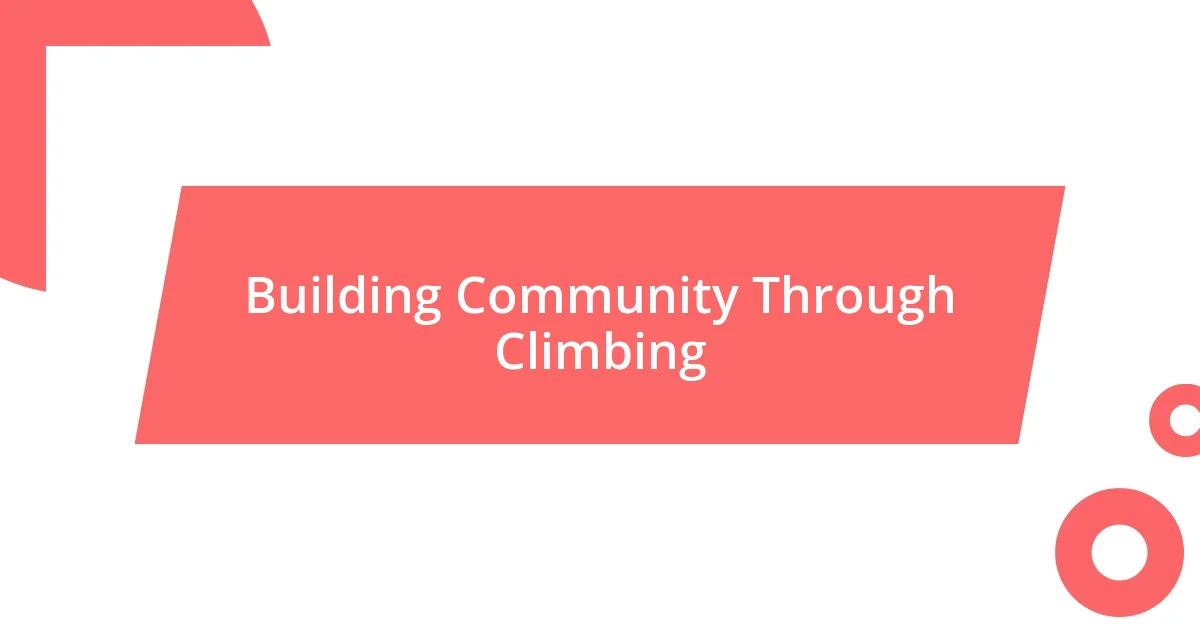Key takeaways:
- The sense of community and support in climbing fosters personal growth and resilience, turning challenges into shared experiences.
- Finding one’s unique climbing style is a journey of personal discovery that enhances both climbing and life challenges.
- Setting incremental goals and tracking progress within the climbing community cultivates motivation and a deeper appreciation for the journey.

My Initial Interest in Climbing
I remember the first time I stepped into the climbing gym, my heart raced with excitement and trepidation. The vibrant colors of the holds and the dynamic energy of climbers scaling the walls drew me in, but what truly hooked me was the sense of community. Have you ever felt that electric spark of camaraderie, where everyone encourages each other to push their limits?
After a few introductory sessions, I found myself captivated by the challenges each climb presented. There was something deeply fulfilling about strategizing my next move and discovering the best way to conquer a route. I still recall my fingers gripping the cool plastic holds, sensing the rush of adrenaline mixed with a hint of fear—was I really going to make it to the top? It felt as though each ascent was a metaphor for overcoming obstacles in life.
As I progressed, I couldn’t shake the sense of freedom that came with climbing. It’s crazy how a seemingly simple act of scaling walls can evoke such profound emotions. Each ascent became an escape from my daily routine, awakening a passion I didn’t know existed within me. What if seeking out that pure exhilaration was the key to finding joy in other aspects of life?

Discovering My First Boulder Gym
Stepping into my first boulder gym felt like entering a whole new world. I can still feel the rush—the moment the door swung open and the scent of chalk hit me. The first thing I noticed was the impressive bouldering walls, each one radiating a sense of adventure and challenge. As I walked through the space, I was almost overwhelmed by the sounds of laughter, encouragement, and the soft thud of climbers landing on mats. It was here that I felt an instant connection, as if I had found a home among fellow thrill-seekers.
- Friendly faces greeted me, eager to share tips and stories of their own climbing journeys.
- I was amazed at how supportive everyone was, even while scaling intimidating routes.
- The energy was contagious; it sparked a desire in me to push myself beyond my comfort zone.
- I remember joining a small group of climbers ready to tackle a new problem, their enthusiasm igniting my own.
- This sense of belonging filled me with a warmth I hadn’t expected, making each visit to the gym something I looked forward to.

Overcoming Early Challenges in Bouldering
Overcoming those initial challenges in bouldering was a journey in itself. I vividly remember my first few attempts at even a basic boulder problem. The holds felt too far apart, and my muscles screamed in protest as I struggled to balance. More than once, I thought about giving up, yet something inside pushed me to try again. Have you ever faced a moment where perseverance suddenly transformed frustration into triumph? For me, that shift came when I learned to embrace each fall as an important part of the process.
As I continued to challenge myself, a breakthrough moment occurred during a group session. I was attempting a problem that had stumped me for weeks. Suddenly, a fellow climber who had been struggling with a separate challenge offered me advice. That interaction shifted my perspective entirely. It’s interesting how sharing struggles can create a bond between climbers, isn’t it? Encouragement from others helped me push through mental blocks, reinforcing the idea that overcoming challenges is often easier with community support.
Every climb became a lesson in resilience. The fear of failing transformed into excitement for the next attempt, and I began to appreciate the journey, not just the destination. I still recall the taste of victory when I finally completed a problem I’d once deemed impossible. It was a rush—proof that persistence pays off. Isn’t it enlightening how each challenge, when faced head-on, can lead to personal growth? In bouldering, just like in life, the most challenging moments often yield the most rewarding experiences.
| Challenge | Overcoming Strategy |
|---|---|
| Physical Fatigue | Break problems into manageable sections and take short breaks. |
| Mental Blocks | Seek guidance from fellow climbers and visualize success. |
| Fear of Falling | Practice falling safely and slowly build confidence on the wall. |

Building Community Through Climbing
The moment I first connected with the climbing community, it felt like discovering a hidden treasure. One evening, after a particularly tough session, I found myself chatting with a stranger about our shared struggles. We quickly bonded over our failures on the same problem, exchanging laughter and tips like old friends. That’s when I realized something profound—every climber you meet has a story to share, weaving an intricate tapestry of experiences that pulls you in closer.
As I attended more meetups and events, the climbing community began to feel like an ever-expanding family. There’s a unique magic in the shared excitement of overcoming challenges together. I still remember the first time I belayed a friend on a route she had never even attempted before. Watching her conquer that wall not only filled me with joy but also solidified our camaraderie. Doesn’t it feel amazing to celebrate someone else’s victory as if it were your own?
Every chalked hand and every cheer echoing through the gym confirms a truth I’ve come to cherish: climbing isn’t just an individual sport; it’s a collective journey. The bonds formed between climbers often go beyond the walls, turning into friendships that extend into everyday life. I’ve found myself meeting people who inspire me not just in climbing, but in many aspects of life. And sometimes, when you’re belaying a friend, you realize that while each ascent is personal, the journey is undeniably shared.

Finding My Style in Bouldering
Finding my style in bouldering felt like a personal discovery. I remember my first few sessions, where I tried to imitate climbers who seemed to glide effortlessly up the wall. It was frustrating, as I quickly learned that mimicking others didn’t highlight my strengths. Have you ever felt that disconnect between what seems right and what feels right? That moment of realization propelled me to explore my own movements, focusing on what my body naturally wanted to do.
As I grappled with different climbing techniques, I began to appreciate the diversity of styles. Some climbers approached problems with sheer power, while others glided smoothly using elegant footwork. I found joy in a more dynamic style—letting my body swing and flow with the problem rather than just forcing my way up. Remember that exhilarating moment when you finally find your rhythm? I can recall the rush of confidence I felt executing a powerful dyno, when I leaped for a hold just out of reach, feeling the air passing by as I flew upward.
Over time, I embraced the idea that my climbing style was a reflection of my personality. It’s not just about the physical aspect; it intertwines with my approach to challenges in life as well. Aren’t we all looking for ways to express ourselves authentically? Whether I’m reaching for a hold or navigating a tough decision, I’ve learned to trust my instincts and make each ascent uniquely mine. Each time I step onto the bouldering wall, I’m reminded that finding style is more than just technique—it’s about embracing my individuality in every move I make.

Setting and Achieving Climbing Goals
Setting achievable climbing goals is a thrilling process for me. When I first started bouldering, I set my sights on a challenging V3 problem that felt insurmountable. I remember the mixture of determination and doubt swirling in my mind as I faced that wall. I thought to myself, “What if I can’t do this?” But breaking the goal down into smaller, manageable steps made a world of difference. I began by understanding the key moves, practicing each one until they transformed from daunting challenges into achievable parts of my journey.
Tracking progress became my constant companion. I created a training log to document every session, celebrating the small victories—like sticking a hard hold or mastering a tough sequence. Don’t you think there’s something powerful about watching your own growth on paper? Each tick on my list ignited further motivation, pushing me closer to my ultimate goal, while reminding me that every climb, big or small, matters. I built a sense of accountability not just to my goals, but also to the community, sharing my climbs and fears with fellow climbers who understood the highs and lows of the journey.
I’ve also found that adapting my goals over time is part of the adventure. When I achieved that V3, I felt a mix of elation and a twinge of longing for the next challenge. Have you ever experienced that moment where you achieve something yet crave more? It’s a powerful reminder that growth is ongoing. Now, I set seasonal goals—one for technique, one for endurance, and another for strength—ensuring that I not only scale new heights but also deepen my love for bouldering in every form. Embracing the journey of goal-setting makes each ascent not just about reaching a peak, but about celebrating the entire climb itself.















